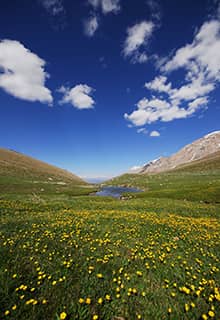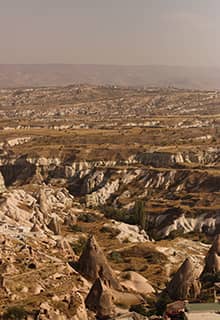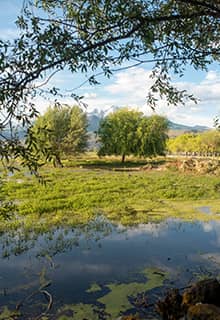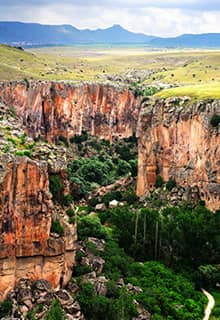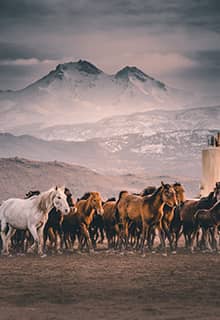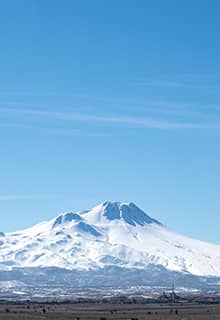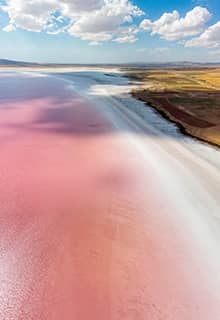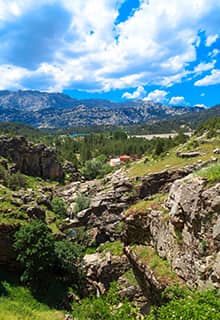

plateaus Central
Türkiye
About the Central Anatolia Region
- Central Anatolia is known as “the cradle of civilizations”.
- It is home to the capital of the nation at Ankara but also to the famous fairy chimneys of Cappadocia and it is the land of the Mevlana, the mystic founder of the Whirling Dervishes, in Konya.
- The region boasts many interesting things to see and do and has many fine museums and monuments.
Central Anatolian Plateau
Bounded by Ankara, Konya, Karaman, Kahramanmaraş, Sivas and Amasya, the Central Anatolian plateau (altitude 1000 to 2000 m) hosts the incredible “moonscape” terrain of Cappadocia, as well as cities founded by the Hittites 3000 years ago, and even older settlements dating back an incredible 7500 years.
The region boasts striking scenery, fine museums, hundreds of Roman archaeological sites, and mediaeval Seljuk Turkish mosques and caravanserais.
Aksaray
Aksaray has many claims to fame; the wonderful Ihlara Valley with its early Christian rock-cut churches is here; there are Underground Cities here; Salt Lake (Tuz Gölü) is here and Mount Hasandağı is here. Add to these its ancient cities, spa centres and destinations for faith tourism and you have one of the best parts of Cappadocia.
Amasya
One of Türkiye’s most charming towns, built in a narrow river gorge, with ancient rock-cut cliff tombs, fine mosques, old Ottoman houses, and even mummies!
Ankara
The nation’s capital, Ankara is a thriving city with a mix of government workers, university students, bankers and doctors populating the city. Situated on the hilltop overlooking the city is Ankara Castle and the old town lies inside its walls. The Museum of Anatolian Civilizations is situated beneath the castle walls and houses the largest collection of Hittite artefacts in the world as well as a staggering array of other pieces. It is well worth a visit.
Beyşehir, Konya
This town on the eastern shore of the large Beyşehir Lake boasts one of the finest and most unusual Seljuk Turkish mosques in Anatolia, the Eşrefoğlu Mosque.
Boğazkale, Çorum
The 3000-year-old capital of the Hittite Empire; the ruins are mostly mere foundation outlines, but the site is striking and the religious reliefs of Yazılıkaya connect you directly with the Hittite’s ancient ceremonies.
Cappadocia, Nevşehir
Cappadocia is an area of unparalleled natural wonders. Geological formations called fairy chimneys — formed from sedimentary rock of ancient volcanic eruptions — are the main draw to the area, bringing thousands of visitors yearly to central Türkiye to explore and witness this otherworldly landscape for themselves.
Kayseri
Set on the eastern edge of Cappadocia, in the shadow of Mount Aergius (Erciyes Dağı, 3916 m), this ancient city has outstanding Seljuk Turkish architecture (1100s to 1200s), interesting bazaars.
Konya
Konya is located on south western edge of the central Anatolian plateau. It is the seventh most populous city of Türkiye. The region has been inhabited since the 3rd millennium BCE. Konya was the last home of Rumi (Mevlana) whose followers are known as Whirling Dervishes.
Nevşehir
Along with Kayseri, one of the chief cities of Cappadocia, with its major bus station and Nevşehir Kapadokya Airport.
Niğde
An ancient city with several notable historic buildings, it is near the striking Byzantine troglodyte monastery of Eski Gümüşler and on the way to beautiful Aladağ National Park.
Safranbolu, Kastamonu
The village of Safranbolu which is recognized by UNESCO as a world heritage and international cultural area due to its Ottoman era architecture, is a must-see place in Karabük. Safranbolu is also known for the Bulak Cave which is one of the largest caves in Türkiye. With its forests, canyons and small lakes; Karabük is a perfect place for travellers.
Sivas
An important trade centre during the Middle Ages, Sivas stood on the caravan routes to Persia and Baghdad. Between 1142 and 1171 it was the capital of the Danişmend Emirs and was an important urban centre during Seljuk rule.

